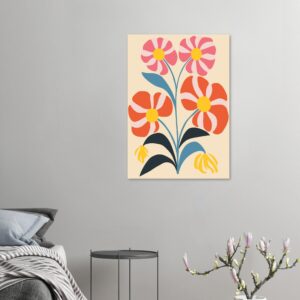Exploring Minimalist Art: The Beauty of Simplicity
As we delve into the origins of minimalist art, we find ourselves tracing back to the mid-20th century, a time when the art world was undergoing significant transformations. Emerging in the late 1950s and gaining momentum through the 1960s, minimalist art arose as a reaction against the complexities and emotional intensity of abstract expressionism. Artists sought to strip away the excesses of previous movements, focusing instead on simplicity and clarity.
This shift was not merely aesthetic; it was a philosophical stance that questioned the very nature of art itself. We can see how figures like Donald Judd, Agnes Martin, and Dan Flavin began to explore the use of industrial materials and geometric forms, emphasising the importance of the artwork’s physical presence in space rather than its emotional content. In this context, we also recognize that minimalist art was influenced by various cultural and philosophical movements, including Zen Buddhism and the Bauhaus school.
These influences encouraged a focus on purity and functionality, which resonated deeply with artists who were eager to break free from traditional artistic conventions. The minimalist movement was not confined to visual arts alone; it permeated music, literature, and design, creating a holistic approach to simplicity that challenged societal norms. As we reflect on this historical backdrop, we see how minimalist art emerged as a powerful statement about the nature of existence, inviting us to reconsider our relationship with art and the world around us.
The Principles of Minimalist Art: Less is More
The Aesthetics of Minimalism
In minimalist artworks, we often encounter a limited colour palette, geometric shapes, and an absence of intricate details. This deliberate reduction serves to heighten our awareness of the materials used and the space they occupy. By stripping away distractions, minimalist artists invite us to engage with their work on a deeper level, prompting us to contemplate the essence of what we are experiencing.
A Broader Cultural Shift
Moreover, this principle extends beyond aesthetics; it reflects a broader cultural shift towards minimalism in various aspects of life. As we navigate an increasingly complex world filled with information overload and consumerism, the minimalist approach offers a refreshing alternative. It encourages us to prioritise quality over quantity, fostering a sense of clarity and purpose in our lives.
A Lifestyle Philosophy
By embracing minimalism, we can cultivate an environment that promotes mindfulness and intentionality, allowing us to focus on what truly matters. In this way, minimalist art serves as both an artistic movement and a lifestyle philosophy that resonates with our contemporary experiences.
The Impact of Minimalist Art on Contemporary Culture
The impact of minimalist art on contemporary culture is profound and far-reaching. As we look around us today, we can see its influence permeating various domains, from fashion to interior design and even technology. The clean lines and uncluttered aesthetics characteristic of minimalist art have inspired designers to create spaces and products that prioritise functionality and simplicity.
In our homes, we often find ourselves gravitating towards minimalist designs that evoke a sense of calm and order, reflecting our desire for tranquillity in an otherwise chaotic world. This cultural shift towards minimalism has also led to a growing appreciation for craftsmanship and quality materials, as we seek to surround ourselves with objects that resonate with our values. Furthermore, minimalist art has sparked important conversations about consumerism and sustainability in contemporary society.
As we become increasingly aware of the environmental impact of our choices, many of us are drawn to the idea of living with less. Minimalist art challenges us to reconsider our relationship with material possessions and encourages us to find beauty in simplicity rather than excess. This cultural movement has given rise to various initiatives promoting sustainable living practices, such as decluttering and mindful consumption.
By embracing minimalism, we not only enhance our personal well-being but also contribute to a collective effort towards a more sustainable future.
The Beauty of Simplicity: How Minimalist Art Evokes Emotion
In exploring the beauty of simplicity within minimalist art, we discover how this movement evokes profound emotional responses despite its apparent restraint. The absence of elaborate details allows us to focus on the fundamental aspects of an artwork—its form, colour, and texture—creating an intimate connection between the viewer and the piece. This connection often leads us to experience a sense of calmness and clarity as we engage with the artwork on a deeper level.
The simplicity inherent in minimalist art can evoke feelings of serenity, introspection, and even joy, reminding us that beauty does not always need to be extravagant or complex. Moreover, minimalist art invites us to confront our own emotions by providing a space for reflection. In a world filled with noise and distractions, these artworks serve as a sanctuary where we can pause and contemplate our thoughts and feelings.
The starkness of minimalist pieces encourages us to strip away our own mental clutter, allowing us to connect with our inner selves. As we immerse ourselves in this experience, we may find that the simplicity of minimalist art resonates with our own desires for clarity and peace in our lives. In this way, minimalist art transcends its visual appeal; it becomes a powerful medium for emotional exploration and self-discovery.
Exploring Minimalist Art in Different Mediums: Painting, Sculpture, and Architecture
As we explore minimalist art across various mediums—painting, sculpture, and architecture—we begin to appreciate its versatility and adaptability. In painting, artists like Ellsworth Kelly and Frank Stella have employed bold colours and geometric shapes to create works that challenge traditional notions of representation. Their canvases often feature large blocks of colour or simple patterns that invite us to engage with them on both visual and conceptual levels.
By reducing their compositions to essential elements, these painters encourage us to reconsider our perceptions of space and form while simultaneously evoking emotional responses through colour dynamics. In sculpture, artists such as Richard Serra and Donald Judd have utilised industrial materials like steel and concrete to create monumental works that interact with their surroundings. These sculptures often emphasise scale and spatial relationships, inviting us to navigate around them and experience their physical presence in real-time.
The tactile nature of these materials further enhances our engagement with the artwork as we move through space. Similarly, in architecture, minimalist principles have influenced contemporary designs characterised by clean lines, open spaces, and an emphasis on natural light. Architects like Tadao Ando have created structures that harmonise with their environments while embodying simplicity in form and function.
Through these diverse mediums, minimalist art continues to inspire innovation while challenging our understanding of aesthetics.
Minimalist Art and Environmental Consciousness: Sustainability and Simplicity
In recent years, there has been a growing recognition of the connection between minimalist art and environmental consciousness. As we grapple with pressing issues such as climate change and resource depletion, many artists are using their work to advocate for sustainability through simplicity. By embracing minimalism in their artistic practices—whether through the use of recycled materials or by creating works that highlight ecological themes—these artists encourage us to reflect on our own consumption habits and their impact on the planet.
This intersection between art and environmental awareness serves as a powerful reminder that creativity can be harnessed as a tool for social change. Moreover, minimalist art’s emphasis on simplicity aligns seamlessly with sustainable living practices. As we strive to reduce waste and live more intentionally, the principles inherent in minimalism resonate deeply with our desire for a more harmonious existence with nature.
By adopting minimalist approaches in our daily lives—such as decluttering our spaces or choosing quality over quantity—we can cultivate an environment that reflects our values while minimising our ecological footprint. In this way, minimalist art not only inspires aesthetic appreciation but also fosters a sense of responsibility towards our planet.
Minimalist Art and Mindfulness: The Connection between Art and Mental Well-being
The connection between minimalist art and mindfulness is an intriguing aspect that merits exploration. As we engage with minimalist artworks characterised by their simplicity and clarity, we often find ourselves entering a state of mindfulness—a heightened awareness of the present moment. The absence of visual clutter allows us to focus our attention fully on the artwork itself, creating an opportunity for introspection and contemplation.
This meditative quality inherent in minimalist art can serve as a powerful tool for enhancing mental well-being by encouraging us to slow down amidst the chaos of modern life. Furthermore, engaging with minimalist art can promote emotional resilience by fostering a sense of calmness and balance within ourselves. In times of stress or uncertainty, immersing ourselves in these artworks can provide solace—a reminder that beauty can be found in simplicity.
By cultivating mindfulness through our interactions with minimalist art, we can develop greater emotional awareness and resilience in navigating life’s challenges. This connection between art and mental well-being underscores the transformative power of creativity as a means for self-care and personal growth.
Exploring Minimalist Art in Everyday Life: Applying Minimalist Principles to Design and Lifestyle
As we consider how to incorporate minimalist principles into our everyday lives, we recognize that this approach extends far beyond the realm of art; it permeates design choices and lifestyle decisions as well. In interior design, for instance, embracing minimalism often involves curating spaces that prioritise functionality while eliminating unnecessary clutter. By selecting furniture pieces that are both aesthetically pleasing and practical—such as multifunctional items—we can create environments that promote tranquillity and ease.
This intentionality in design encourages us to surround ourselves only with objects that bring joy or serve a purpose. Moreover, applying minimalist principles to our lifestyles can lead to profound changes in how we approach consumption and relationships. By adopting a mindset focused on quality over quantity—whether in our possessions or social interactions—we can cultivate deeper connections with what truly matters in life.
This shift encourages us to prioritise experiences over material goods while fostering gratitude for what we already have. Ultimately, exploring minimalist art in everyday life invites us to embrace simplicity as a guiding principle—one that enhances not only our physical spaces but also enriches our overall well-being as individuals navigating an increasingly complex world.








